The difficult fate of the Tu-14
The arrival of Germany with the United States and the United Kingdom of aircraft with turbojet engines (TRD) marked a new era in aviation development. A jet engine made it possible to significantly increase speed, capacity, reliability, and reduce maintenance labor costs (at least on the first jet machines).
The need for a transition to new jet technology in the USSR was quite obvious to everyone. However, the circumstances were by no means in favor of the Soviet engine industry, which during the war did not have the opportunity to engage in advanced developments in the field of jet engines, and in the mid-forties, could not offer anything aviation design bureau. Therefore, for the first Soviet jet engines it was necessary to use the German trophy turbojet engines YuMO 004 and BMW 003 with an extremely low thrust of 800-900 kgf. In our country, these motors were introduced into mass production under the names RD-10, RD-20.
The situation with jet engines improved after the Soviet Union received in 1947, the British TRD "Derwent-V" and "Ning-1" company "Rolls-Royce", received in serial production of the name RD-500 and RD-45. "Derwent-V" possessed 1600 kgf, and "Nin-1" - 2272 kgf. It was these engines that made it possible to create full-fledged domestic front-line jet bombers.
In OKB A.N. Tupolev was the first jet engine aircraft "77" or Tu-12, released for factory testing in July 1947. The aircraft was created on the basis of the Tu-2С piston bomber. When developing the 77 aircraft, the idea was realized: to get a combat jet machine in the shortest possible time by replacing the power plant and minimal changes in the spent basic design. A small series of Tu-12 bomber was laid. However, there were only three aircraft. Tu-12 passed Factory and State tests, during which it was possible to achieve a maximum speed equal to 783 km / h.
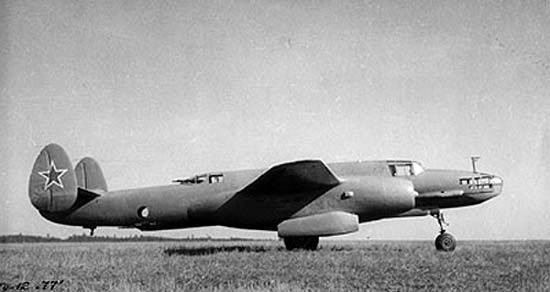
Designers OKB closely acquainted with the peculiarities of the new type of power plants on the plane. British NINs have passed the test. The nuances in operation were revealed, new approaches were developed, which are necessary when designing aircraft with a turbojet engine. A small number of built Tu-12 allowed the pilots of the Air Force, at least part of them, who flew them to the Scientific Research Institute of the Air Force, to get acquainted with the new jet technology and prepare part of the flight crew for the introduction of fundamentally new vehicles. Tu-12, in fact, became a transitional aircraft from piston machines to jet. They did not transmit it to the big series, realizing that a full-fledged jet bomber must be created on the basis of modern technologies using the latest types of equipment and weapons.
In 1947, in the OKB A.N. Tupolev at the same time began work on several projects of front and long-range bombers using TRD. The first group of projects presented airplanes using combined power plants, combining the usual piston engines with turbojet engines. The second group - airplanes with TRD.
The very first work on the projects of the first group very quickly showed that this path was a dead end: it was difficult to ensure the simultaneous efficient operation of two dissimilar types of engines with different types of fuel on one plane. Development in this direction were soon discontinued.
But the work on the machines with a single power plant was developed and eventually led to the creation of a serial torpedo bomber Tu-14T, equipped with two TRD VK-1. But up to this point, the aircraft has come a long way of development and improvement.
In early January, the 1947 in the Design Bureau initiated design work on the design of the 73 aircraft with two NIN-1 jet engines having 2000-2100 takeoff thrust kgf. “73-s” in this version was supposed to reach a maximum speed of 850 km / h, have a range of at least 3000 km, carry a bomb load of up to 3 tons and have a crew of 4-s people. Defensive armament was provided from one 23-mm gun in the nose and two 20-mm guns to protect the rear hemisphere.
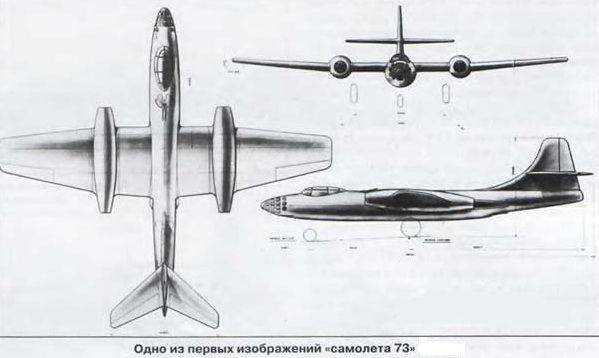
Careful study of the task and the TTT Air Force showed that the plane with two "NIN-1" will not be able to achieve the required data. Therefore, in April 1947, A.N. Tupolev proposed to install an additional engine “NIN-73” on the “1” in the rear fuselage, which was replaced during the design on TRD “Dervent”, with a maximum take-off load of 1590 kgf. This third engine was intended only for receiving at the necessary moment additional thrust for takeoff and departure from enemy fighters.
In the OKB, the work on the new project was headed by the deputy A.N. Tupolev - A.A. Arkhangelsky, directly supervised the work of D.S. Markov. The plane "73" was planned to transfer to the State tests in November 1947. All about everything - design and construction - was given only a few months. Such were the time when the new prototypes were created - the bill went on for hours and days. It was necessary to eliminate the lag of the technical level of Soviet aviation from the West, to master jet technology as a matter of urgency.
At the end of the summer of 1947, all units and parts of the aircraft were launched into production, and construction began at an accelerated pace. 29 December 1947, the new aircraft off the ground and made its first flight. Factory testing ended in June 1948. A maximum speed of 873 km / h and a practical range of 2965 km were obtained. After all the fine-tuning and refinement of the "73" was transferred to the state tests in the Research Institute of the Air Force.
The main drawback of the 73 as a bomber was the absence of a bomber sighting radar. The Cobalt type radar used on the Tu-4 was too cumbersome for a front bomber, and the new radar specially adapted for this class of aircraft was not yet there, it was to be created and mastered in the series.
From 10 in August, 1948 of the year to 31 in May, 1949 of “73” took place in two stages of state testing. During them, the plane was refined according to the comments of the Air Force. On tests there were many failures of the NIN-1 engines, as well as the fuel system. After all the improvements and tests, the military gave an opinion on the prototype aircraft, which stated that the flight characteristics, except for the flight range, were as specified. Among the shortcomings of "73" were: the lack of radar and radio navigation systems, providing bombing out of sight of the earth, weak armor protection for crew members, the absence of anti-icing devices on the wing and tail, the different types of engines.
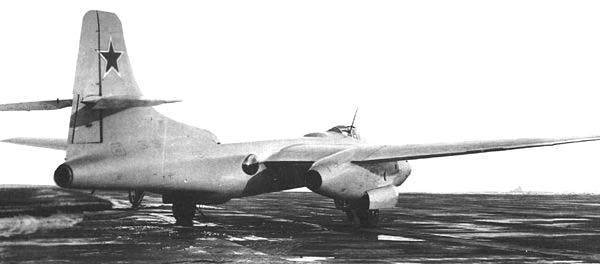
Back in the factory testing period in March 1948, it was decided to produce an experimental series of 10 73 copies with serial TRD RD-45 and RD-500. When transferring to production, the aircraft received the name Tu-14. In the summer of 1948, the Moscow plant No. 23 started the serial construction of the Tu-14. But in the 1949 year, in connection with the transfer to the series of the twin-engine version of the “73 aircraft” to the Irkutsk plant No. XXUMX, the entire reserve for the series was transferred to this plant. Thus, the aircraft "39" remained in the only experienced flying instance.
It was planned to produce the 73 aircraft in two versions, a front-line bomber and a photo reconnaissance aircraft. The photo reconnaissance aircraft, which received the cipher 78, was constructively different from 73 by a more elongated nose section and an enlarged cross section of its neutral part, raised up by the lantern of the pilot's cabin. Special units were installed in the bomb bay to install cameras AFA-33 / 100. AFA-33 / 75, AFA-33 / 20, AFA-BA-40 (day variant) and NAFA-ZS-50 (night). The fuel reserve has been increased and the nose gear has been changed. An interesting feature of the “78” was the presence of a flap-fairing, which closed the third engine in a cruise flight, on the “73” this flap was not present, although it was provided for in the project.
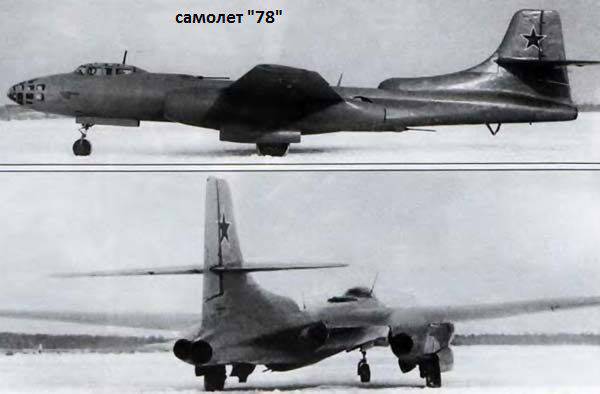
In April, the 1948 of the year the reconnaissance version was manufactured at a pilot plant, and on May 7 flights began on the seventy-eighth. At the end of winter 1949 of the year, the 78 aircraft is transferred to partial state tests, during which the work of photographic equipment and bomber weapons intended for the suspension and discharge of photo bombs was tested. During the testing period, the scout was assigned the Tu-16 index (the first one with this name should not be confused with the average 88 bomber in the Tu-16 series). Tests showed the lack of knowledge of photographic equipment for conducting reconnaissance, which did not allow recommending an aircraft to equip reconnaissance air regiments of the Air Force SA.
Since the summer of 1949, the plane 78 has been testing the possibility of unattended escape from a jet engine. First, mannequins were dumped, and then the paratroopers-testers of the Air Forces performed jumps: Romanyuk, Gladkov, Dolgov, and others. The escape-free escape was tested in flights up to an indicator speed of 600 km / h Later, these works played an important role in the development of systems without a catapult airplane leaving by radio operators from domestic jet machines, as well as for the entire crew of a Tu-95 turboprop bomber, which completely abandoned the ejection seats.
At the beginning of 1948, the VK-45 TRD was created based on the RD-1 engine, which had a maximum thrust equal to 2700 kgf, and the OKB began developing two variants of the 73 aircraft for this engine: a bomber with the 81 cipher with two TRD VK- 1 and photo reconnaissance - “79”, with a pair of VK-1 and one RD-500.
The reconnaissance version of the 79 was developed from the beginning of the 1949, and in the middle of the year the aircraft model was made. In terms of geometry, the 79 is practically no different from the 78. The use of new, more powerful TRD VK-1, made it possible to increase the maximum speed to 933 km / h. Increased to 3750 km and flight range. On the 79 aircraft, the tail-engine fairing valve was no longer mounted, since the RD-500 was also planned to be used on cruising flight modes. The stock of fuel was increasing, at the same time it was supposed to improve the system of photo-intelligence equipment. An important step forward for the “79 aircraft” was the introduction of a PSBN type airborne radar.
However, all the advantages over the 73 and 78 aircraft could not outweigh the main drawback of the car - the presence of different types of engines in the power plant and, therefore, the Air Force eventually abandoned this project. Therefore, all forces were concentrated on the twin-engine modification.
Simultaneously with the 79 aircraft, work was underway on a twin-engine bomber, the 81 aircraft. The initial project envisaged a minimum processing of the 73 aircraft for new requirements and equipment: the removal of the RD-500 third tail engine, the installation of a PSBN radar, etc. Due to the introduction of the radar operator into the crew, its number now amounted to 5 people, which did not arouse the customer's enthusiasm. From the aggregate of all comments to the project, it was rejected, and therefore in the fall of 1949, the OKB prepared a second draft of the project, which had the following differences:
- the fuselage is completely repackaged;
- removed the upper rifle point, leaving the bow gun and aft defensive installation. (This decision was made after a careful examination of AN Tupolev Il-28 bomber, which was tested at the same airfield as the 78 aircraft);
- introduced aft hermetic cabin;
- the crew was reduced from 5 to 3 people (also the type of IL-28), etc.
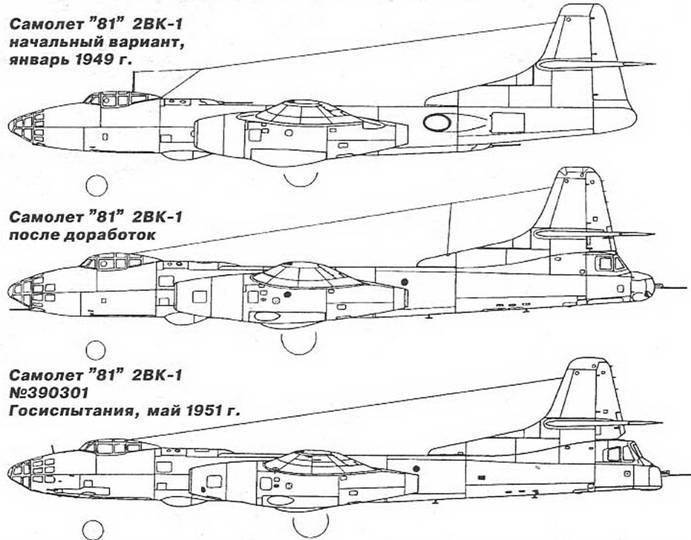
The second option was adopted for construction. In October 1949, the 81 was ready. Such a speed of creating a new aircraft was explained by the maximum use of the airframe of the serial “73” from the reserve of Plant No. XXUMX, as well as Tupolev’s concern that Ilushin and his IL-23 would be ahead of him.
13 October 1949 began factory tests. Led them, like the previous tests of the aircraft of this series, F.F. Opadchiy. On these tests, the range 3110 km was reached, the speed reached 870 km / h. The 81 aircraft was recommended for state tests that took place from January to May of 1950.
Basically, the results of these tests confirmed the fulfillment of customer requirements for a new front-line bomber. The operation of the cannon aft installation, the absence of ejection seats for the crew were found to be unsatisfactory, there were comments on equipment and aircraft systems.
The prototype is urgently refined and re-enters the repeated factory tests, which took place in August-September 1950. In the new form, “81” was equipped with ejection systems for the pilot and gunner-radio operator. The review for the navigator has been improved. The total length of the fuselage and the size of the bomb compartment directly increased. The aircraft received a new cannon aft installation of increased dimensions, with extended firing angles, for which it was necessary to cut off the lower part of the rudder. During the modifications, a new main cannon installation was mounted. Factory tests of the modified 81 aircraft were conducted by test pilot A.D. Flight.
From the autumn of 1950 of the year to the beginning of 1951 of the year, the 81 aircraft passed repeated state tests in the GK NII VVS. The military pilots gave, in general, a positive assessment of the aircraft, but noted a large runway distance and an insufficient rate of climb, as a result, they did not recommend 81 for adoption by the Air Force.
Noting the ability of the Tu-14 (such a designation gets "81" at the stage of state tests) to take on a wide range of mine-torpedo weapons, the presence of perfect navigation equipment and long range at that time, the Scientific Research Institute of Air Forces recommended the Tupolev machine for naval aviation. In fact, the essence of the conclusion spoke about one simple truth: by this time, the Air Force received an excellent front-line bomber of the Design Bureau S.V. Ilushin Il-28, which was created in 1948, in a proactive manner. The Ilyushin aircraft was lighter, while having the same two VK-1, which naturally made it possible to get the best flight characteristics. In addition, the IL-28 was more adapted for large-scale production.
Ilyushin residents won the race at that time, and their IL-28 was launched into mass production. Well, Tu-14 Tupolev attaches to sailors, and until the end of the fifties this machine serves navy as a torpedo bomber and director of mines.
While there were improvements, refinements and endless tests of the Tu-14, mass production took place at the aircraft plant No. XXUMX in Irkutsk. Supervised by the OKB development of a series of P.O. Dry, at this time deprived of its design bureau and returned to A.N. Tupolev. The first serial Tu-39 was made in July 14 of the year, after which it was converted into a torpedo bomber Tu-1950T ("14T"). The second serial copy has become a prototype of a photo reconnaissance (aircraft "81").
The Tu-14T, unlike the bomber, changed the glazing of the navigator's cockpit, mounted a torpedo bridge for the suspension of torpedoes, modified the equipment for using mine-torpedo weapons. Until the end of April, the Tu-14T was on state tests, after which it is recommended to adopt the aircraft of the USSR Navy as a torpedo-destroyer. In the fall of 1952, the standard Tu-14T was put to the test, on which the reservation was strenuously established, the ejection seat of the navigator, anti-icers, high-power DC generators, etc. was installed. In this final form, the Tu-14T was handed over to the series and adopted by the Navy aviation. At the same time, military tests of the Tu-14T nines were going on at the Black Sea Fleet, deciding the fate of the aircraft. TU-14T was put into operation naval aviation.
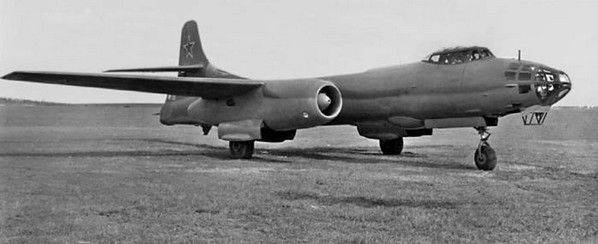
Tu-14Ts were successfully used in naval aviation until the end of the fifties, when they were replaced by Tu-16. Even after the removal of these vehicles from the arsenal, at the end of the fifties, the Tu-14T "underground" continued to remain in the shelves. The flight and commanders loved these cars for their amazing volatility and high reliability. And for a long time in parts of the Navy aviation, the Tu-14 was used for training of flight personnel.
Over the years, 89 serial machines were transferred to the fleet. The development of a new jet torpedo carrier by naval aviation units began in 1952. The development of the aircraft by the combat units passed fairly quickly and without serious accidents. Ground and, in particular, flight personnel, retrained on a jet engine with great desire and enthusiasm. The engineering staff noted that servicing the Tu-14 was much easier than piston-driven machines. The technicians' jackets were no longer so greasy. Techies have found a neat and even somewhere smart-looking. Retraining was somewhat complicated by the lack of a training option with dual controls. Therefore, retraining was done in the 2-3 stage. In a three-stage scheme, initially pilots were trained in the characteristics of aircraft with a nose wheel landing gear (IL-12, A-20).
Subsequently, for training began to use the VI-28. After the 8-9 training flights, the pilots were transferred to the Tu-14. At the same time, the difference in control between these aircraft was enormous. The levers, cranes, and consoles of these machines, which had the same purpose, were located in completely different places and sometimes required working in opposite directions. Also, Tu-14 and VI-28 differed behavior in flight and taxiing, which did not facilitate the task of training.
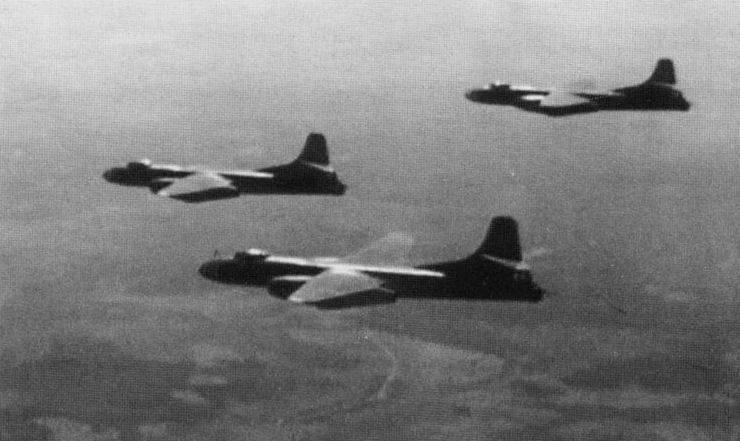
At the very first trainings in the cockpit, the pilots noted that the Tu-14 has a “weak-eyed flashlight,” with many broad bindings. The cockpit on the IL-28U was smaller, but it provided an excellent overview and made a favorable impression, according to the pilots, “was warmer”, which cannot be noted when talking about the more spacious, but some untidy cabin, the Tu-14. This is what Lieutenant-General I.I. Borzov (later became commander of naval aviation): “Estets! Design at the village forge level! ”
In flight, the Tu-14 had excellent stability, which the pilots liked. But in order to perform the maneuver of the Tupolev machine, greater efforts were needed than on the IL-28 to deflect the rudders. But when climbing to 8000 meters and above, the picture changed, here already the Tu-14 was easier to manage than the Ilyushin machine. The reason for this was the fact that Tupolev used rigid control wiring, and on the Ilyushin machine it was a cable. Also hard wiring contributed to a more stable flight on autopilot, the altitude was maintained better than on the IL-28. In the course of practicing the combat use of the Tu-14, another feature of the machine was revealed: after the opening of the shutters of the bomb bay, the torpedo bomber acquired excessive traveling stability, due to which there were difficulties with side laying. Therefore, it was recommended that bombs be opened immediately before dropping the combat load.
Especially for the Tu-14T, a high-altitude straight torpedo was developed, which was put into service in 1953 under the name PAT-52. This torpedo allowed to be used at flight speeds up to 800 km / h and heights of at least 1500 m. A feature of PAT-52 was the use of a rocket engine on it, which provided an increase in speed to 68 nodes (130 km / h), which 1,5 times the speed other torpedoes. In addition to bombs and PAT-52, the Tu-14T could use the low-altitude torpedo 45-56 NT, induction hydrodynamic mines AMD-4-500, AMD-4-1000 and AMD-2M.
The Tu-14T aircraft was in service with the mine-torpedo regiments of the aviation of the northern, Pacific and Black Sea fleets. However, he was not prepared for long service in military units. Already by the 1957 year, virtually all of the mine regiments of the mine-torpedo aircraft were transferred to the IL-28, although in fairness, it is worth noting that in some respects it was still inferior to the Tupolev machine: it had a smaller range, not so modern equipment, there were no maritime rescue equipment .
To date, not a single copy of the Tu-14T has been preserved. It can now be seen only in photographs, restored drawings and models.
As already mentioned, the second production machine «81» was converted into a reconnaissance version - the aircraft «89». Since February, 1951 test pilot A.D. Flight, conducted factory tests on this machine. The normal operation of photographic equipment was noted, which was a sore point for all Soviet photo prospectors, starting with the Tu-2. After some modifications, the aircraft was prepared for transmission to the series, but by that time the fate of the base Tu-14 had already been decided. In addition, the SV Ilyushin Design Bureau developed the IL-28P photo reconnaissance camera based on the IL-28, which was easier and cheaper to put into production, and besides the IL-28Р did not create the problem of the heterogeneity of the front-line aviation fleet. Therefore, it is not surprising that the Air Force has relied on the IL-28P, and the 89 aircraft did not become a serial one.
A.N. Tupolev in 1952 year attempted a radical modernization of the Tu-14. The design of the aircraft "93", which was a new torpedo bomber, with a pair of powerful turbojet engines VK-5 or VK-7 was developed. A bit earlier, the project “84”, based on the airframe “73” with two turboprop engines VK-2 and one RD-500, was worked out. However, all these projects remained on paper.
The Tu-14 became the platform on which both the Tu-16 and Tu-104, and later OKB aircraft grew. The creation and mass production of Tu-14 aircraft, gave a lot of valuable experience for the further development of the domestic bomber aircraft. It was on this plane that the systems for leaving the bombers in the air at high speeds were worked out, the design speed limits at low altitudes were introduced, which became the norm when designing all subsequent heavy machines, and the pressurized cabins were worked out. In addition, for the first time in the world, a three-engine scheme was tested, which became widespread on many passenger jets in the sixties. Many aviation systems, equipment and armament assemblies, which became standard construction elements on later aircraft, were tested and brought up. And finally, for the AN Tupolev design bureau, this was the first production jet plane, on which, having stuffed a lot of bumps, the team learned a lot.
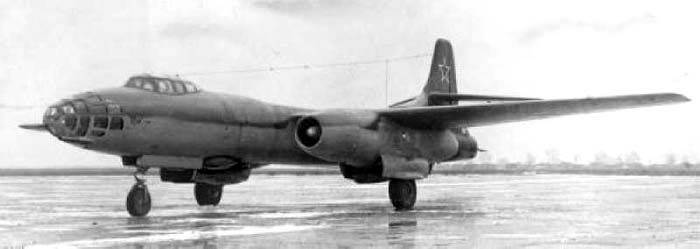

Sources:
Artemyev A., Rigmant V., Saukke M. Family Tu-14 // Aviation World. 1995. No.2. C. 23-37.
Rigmant V. Tu-14 - aircraft of difficult fate // Aviation and Time. 2008. No. 6. C. 4-12
Artemyev A. The Short Age of Torpedo Bomb. About Tu-14 // Wings of the Motherland. 2000. No.4. C. 11-17.
Rigmant V. Last torpedo bomber // M-hobby. 1995. No.5. C. 34-37.
Eger V. Unknown Tupolev. M .: Yauza, 2008. C. 103-116.
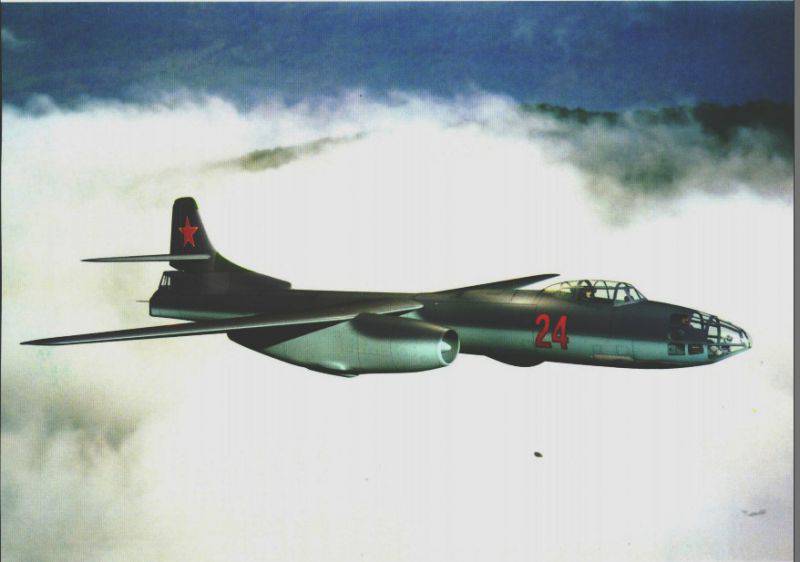
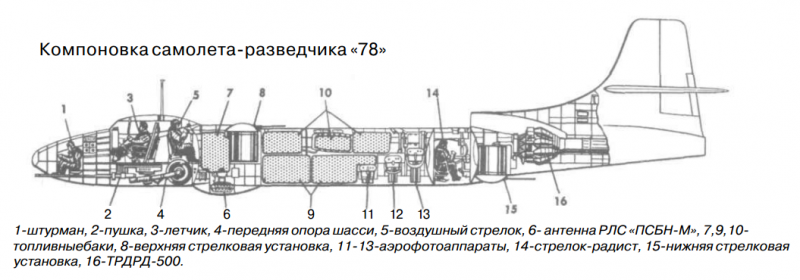

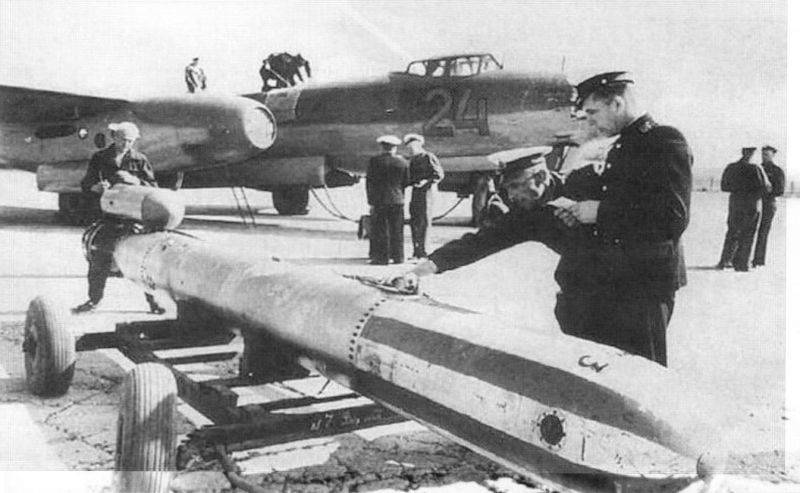

Information